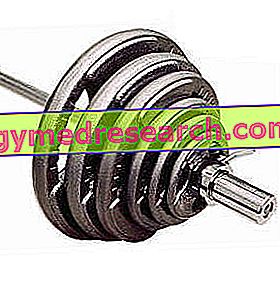Edited by Roberto Calandra
FST-7: the term FST stands for: Fascial Stretch Training, while seven represents the last exercise performed with "7" series.
Surely this training method is not recommended for beginners and / or those who do not have a good ability to perform fascial stretching.
Many believe that the FST-7 differs from the other training methods for the 7 final series; in reality the reason that has caught the attention of many athletes and trainers is the fundamental interaction between training, integration and stretching.

1) Fascial stretching
2) Pre, during and post Work Out integration
Fascial stretching, a very painful practice, according to Hany Rambod (creator of the FST-7), is fundamental during the Work Out, because it is possible to stretch and expand the muscle bands, and through the continuous hydration and integration fill the bands of blood, macro and micronutrients, thus favoring the growth and volume of the muscle bundles themselves.
Now let's see how it is structured specifically:
| Monday: Biceps, triceps and calves | Tuesday: Legs | Wednesday: Rest |
| Thursday: Chest and triceps | Friday: Back and calves | Saturday: Shoulders and biceps |
| Sunday: rest |
From this example we can deduce that:
1) The small muscles are trained in multifrequency
2) Large sections are trained only once
Now let's move on to an example of Work out FST-7 for the Chest:
3 / 4x8-12 flat recovery bench 2 '
Inclined dumbbell bench 3 / 4x8-12 rec 90 "
Chest press 7x10-12 rec 30-45 "(drinking a lot to hydrate the + possible).
As Rambond says, the first series must be heavy.
The 7x10 is not a series of actual pumping; in fact, the first 3 series must be heavy, but above all the 7x10 series must be chosen last, so that the heavy work of the first series is not compromised.
Pumping, as far as you can think, is given by the stretch and the integration of the during which I will analyze shortly.
Another important thing is that the last series must be carried out by performing isolation exercises and not by multiarticulars, in order to deposit as much blood as possible in the area.
Let's see a diagram by Hany Rambond, where it contains the choice of exercises to perform:
Back width: Machine pullovers (Hammer Strength, Nautilus) or cable pullovers
Back thickness: Seated row machines with chest support
Chest: Pec deck or peck flye machine *, cable crossovers
Shoulders: Machine lateral raises with pads - my favorite is made by Bodymasters. Hammer Strength, LifeFitness, and Cybex also produces similar models.
Quads: Leg extensions, leg presses
Hamstrings: Seated or lying leg curls
Biceps: EZ-bar curls, machine curls, cable 'front double biceps curls'
Triceps: Cable pushdowns using rope attachment
Overhead cable extensions
Skull crushers (for advanced trainers)
Calves: Calf raises using leg press
(alternate between these three)
Now, instead, let's take an example of wo of FST-7 of the same Rambond:
| Triceps | Chest |
| Close-grip bench press 3-4 x 8-12 Weighted or machine dip 3 x 8-12 Overhead cable extension 7 x 8-12 (beginner and intermediate) Skull crushers 7 x 8-12 (Advanced) | Incline dumbbell press 3-4 x 8-12 Incline dumbbell flye 3 x 8-12 Flat Hammer or dumbbell press 3 x 8-12 Pec deck or cable crossover 7 x 8-12 |
| Quads | shoulders |
| Leg extensions 3-4 x 8-15 Squats 4 x 8-12 Hack squat or leg press 3 x 8-15 Leg extension or leg press 7 x 8-15 | Seated dumbbell press 4 x 8-12 Barbell or dumbbell front raise 3 x 8-12 Dumbbell lateral raise 3 x 8-12 Lateral raise machine 7 x 8-12 back |
| Warm-up: | hamstrings |
| Neutral-grip chin-ups 3 x failure Wide-grip pulldowns 3 x 8-12 Barbell row 3 x 8-12 Hammer Strength row 3 x 8-12 Machine or cable pullover 7 x 8-15 | Lying leg curls 3-4 x 10-15 Stiff-leg deadlift 3-4 x 10-12 Single leg curl 3-4 x 10-15 each leg Seated leg curls 7 x 10-15 |
| Traps | Rear delts |
| Dumbbell shrugs * 3-4 x 8-12 Machine shrugs 7 x 8-12 | Dumbbell rear lateral raise 3-4 x 12-15 Reverse pec flye or cable 7 x 12-15 Rear laterals |
| Calves | |
| Standing calf raise 4 x 10-12 Seated calf raise 4 x 15-20 Leg press or calf sled raise 7 x 10-12 |
FST-7 integration
Pre Work out:
Rambod recommends a solid meal, generally consumed 1 hour before WO, except for the day of the legs, in which for metabolic reasons it is preferable to consume 90 "before.
The choice falls on complex proteins and carbohydrates.
So like proteins: chicken, turkey, lean red meat cuts, fish.
As carbohydrates: potatoes, oatmeal, rice.
Recommend to avoid monosaccharide carbohydrates, to avoid glycemic collapses.
Another important thing is the intake of water, since it is the most present element of the body and serves to constantly hydrate the muscles.
during:
Here it is recommended to drink plenty of water, also associated with an energy drink rich in carbohydrates.
post:
Within 15-20 minutes of the end of the WO recommends drinking vitargo. Like proteins, on the other hand, the quick release isolates. An hour or two later make a meal similar to pre WO, keeping fat low, especially saturated.
Separate speech, however, for sodium. He recommends taking them regularly, because sodium is an excellent carbohydrate transporter and avoids seeing your flattened muscles. Sodium, if it has to be detached, only 2 days before a race to eliminate the last skin water.
Supplements:
Pre WO: Glycerol, Creatine, Beta-Alanine, Arginine, Whey, Taurine
During: Glutamine, BCAA, Carbohydrates (Vitargo)
Post: Creatine, Taurine, Maltodextrin or Dextrose, BCAA, Beta-Alanine



